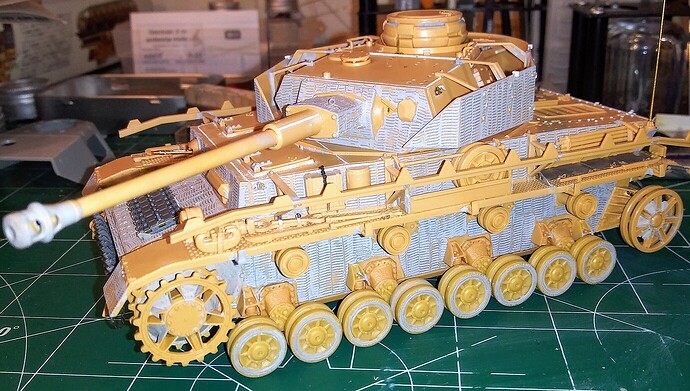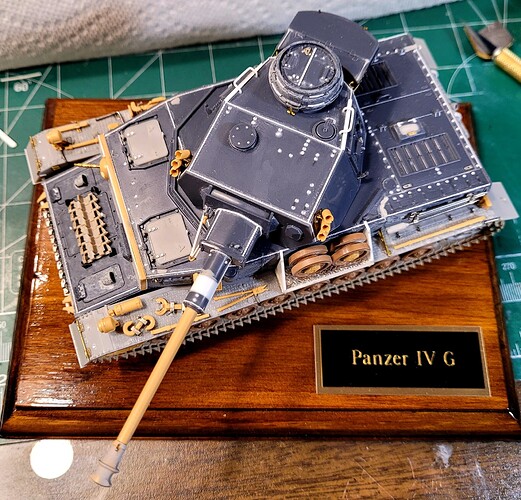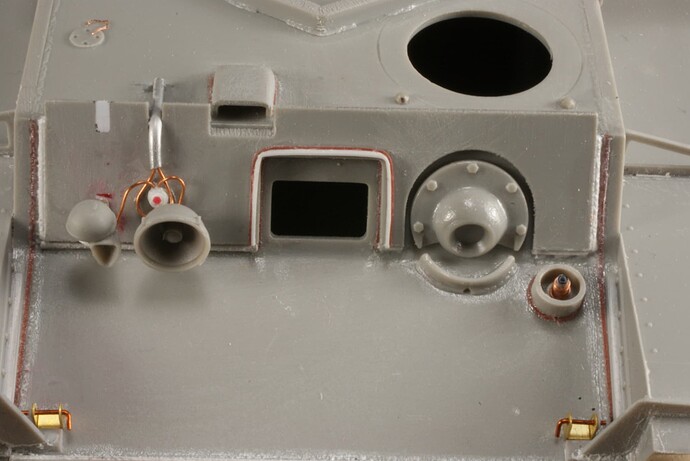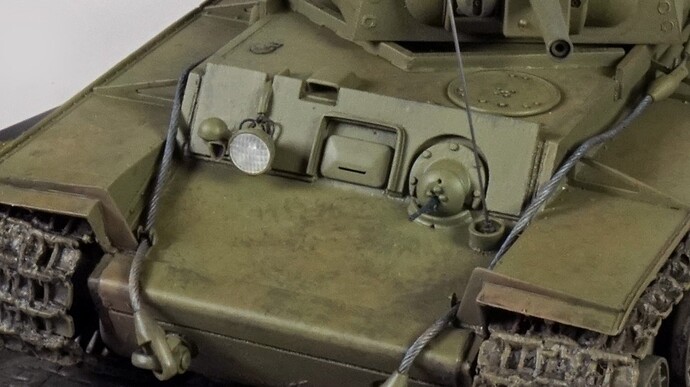In referring to it as ‘water on oil’ exactly as typed, it was meant as a generic description of the effect not chemistry…
OK then, what specifically is there about polyurethane that inhibits the adhesion of paint that does not likewise exist in polystyrene? After all, the entire context of this thread is the OP having difficulty with painting resin but perfectly able to paint styrene.- without primer.
KL
KL
No more difficulty from this OP. The Vallejo top coat had changed from gloss to a nice matt finish. So, on we go with Vallejo primer and tomorrow, a top coat of Air on all the other bigger parts.
That said, all parts were washed in dish soap, toothbrushed with IPA (Im learning). Then washed again.
Blerry hell, there’s a lot to learn in this resin building lark!

Add something positive for a change.
I’m with you on that one Tom, it really is good stuff… I also use the red primer and large cans of matt black, I cant fault them. The Range also do a very good grey primer for plastic, but the can is a bit smaller.
It could be that styrene kits are produced in a controlled industrial process
and most resin kits are produced in a small scale cottage type industry.
I built ICM’s T-35 kit and same oil was almost dripping off the parts,
there were oil stains on the cardboard box. I assume they didn’t have
their industrial process under firm quality control yet.
I suspect mold release agent more than something to do with the
urethane or the styrene as such. The letters ‘poly’ just means many.
" Polyurethane (often abbreviated PUR and PU) is a commonly encountered polymer composed of organic units joined by carbamate (urethane) links. In contrast to other common polymers such as polyethylene and polystyrene, …"
Polyurethane - Wikipedia (Spandex is a PU product …)
Other words with poly are polygon, polyglot, polygamy, polytechnic, polymethyl methacrylate (same meth as in meth but still not an illegal substance), polyactic acid (not acid as in illegal substance acid), polyinosinic-polycytidylic acid (this word can’t be used as a roadside sobriety test since it is nearly impossible to pronounce even when stone cold sober), polyamory (can lead to polygamy), monopoly, poly-paraphenylene terephthalamide (can be used to keep you safe), polyhydroxyalkanoates, polybutyric acid.
There is one fake word in that list ![]()
Polygon - when your parrot escapes…
…don’t forget and Poly-want-a-cracker
For good measure let’s add Polynomial(s) & Pollywogs as a different sort of challenge to paint and get good coverage.
![]()
![]()
I am. I trying to wring something rational, tangible, and usable out of glib statements that don’t withstand even a cursory technical or logical challenge.
In other words, you can’t make the paint stick without knowing what is happening, no matter how positive you think.
KL
I have handled resin parts where it seemed as if the mixture of the two components was off by a small margin. Either too much or too little catalyst resulting in left over catalyst or left over polymer.
If the issue was a misproportioned mix that’s exuding one thing or the other, I don’t think there’s any sort of primer or paint that would adhere to it.
KL
True! Washing it off somehow MIGHT possibly solve it.
Mold release “oil” would be the best cause to hope for.
@Uncle-Heavy @KurtLaughlin No, but soaking the offending parts in strong alcohol or another cleaning solution may clean them out and remove the problem. Time (to allow off gassing and curing/drying of the offending chemicals) can also work, but we are talking years here. Shelf of doom stuff. Otherwise, if the parts are oozzing uncured chemicals, there is not much else to do but throw it away.
Ken
Which is exactly my point. If the resin is completely cured it will no more benefit from a so-called primer coat than polystyrene would, and claims that resin always must be primed (but without the same statement about styrene) don’t hold up. Conversely, if the resin is “leaking” from a bad mix priming isn’t the solution either.
I can understand an initial paint coat to find bubbles and surface defects; I do that myself. That’s not primer though.
KL
Kurt, I also always prime my styrene kits; but for a slightly different reason. I use a lot of photo etch and most paints don’t adhere well to the photo-etch. A good primer sticks to the PE better. It also gives me a consistent color to apply the base coat of paint on.
Rick
Excellent argument for a primer or base coat regardless of paint adhesion on a multimedia composition model in my experience. Brass, aluminum, resin, Brass PE, Stainless steel PE, various colors of plastic, Zimmerit putty, copper wire and so forth.
Unless the paint contains lead, chromium, or zinc, it will not provide any particular advantage in bonding to metals. For some metals, like the ones that are inherently corrosion-resistant, even those additives don’t help much. I have not had any problems with adhesion of acrylic paints to properly cleaned metal, so have not been tempted to try any other preparations…
I agree that having a consistent base color is advantageous, I just use an extra coat or two of my main color coat. The “primers” that are out there are often actually surfacers, which are pretty thick, which helps them cover in one coat. Even if it takes two color coats to cover it’s still thinner than most “primers”, plus I’m already at my color.
Just putting numbers out there, if a color coat is one unit thick the primers are at least one, maybe two or three. So I could go primer + color = 1 + 1 = 2 units thick to get to a uniform base, or color + color = 2 units thick. It’s likely the primer has even more detail-robbing thickness, so it loses it’s appeal to me.
Here’s a model I did that had kit plastic, Evergreen styreme, Slater’s styrene, steel, brass, copper, aluminum, and acrylic texture medium that I covered as described above. It turned out OK.
I will also add that looking at models at shows and online you can certainly tell that the various primers (and 27 layer weathering schemes) have taken hold in the hobby by the muted and softened detail on the models. Some of them look like short-run Eastern European kits from the 1990s.
Oh well.
KL
It’s easy enough to do multiple thin coats without filling in details with properly thinned quality paint. Even with high quality acrylic or enamel paint products if applied in a heavy handed matter, its possible to lose details
Tue 'nuff. A lot of people haven’t learned that skill, however.
KL
Agreed, Kurt. The fad in recent years seems to be to slap a kit together so that one can paint and weather the snots out of it. You don’t have to use every product AK and Ammo make. Sometimes the devil is in the details.




